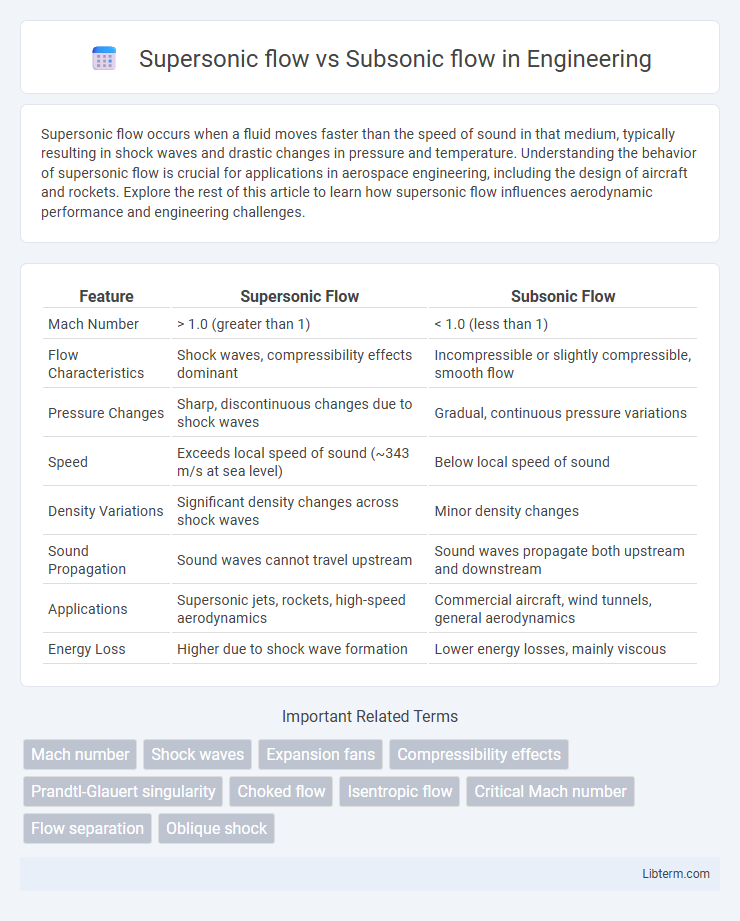Supersonic flow occurs when a fluid moves faster than the speed of sound in that medium, typically resulting in shock waves and drastic changes in pressure and temperature. Understanding the behavior of supersonic flow is crucial for applications in aerospace engineering, including the design of aircraft and rockets. Explore the rest of this article to learn how supersonic flow influences aerodynamic performance and engineering challenges.
Table of Comparison
| Feature | Supersonic Flow | Subsonic Flow |
|---|---|---|
| Mach Number | > 1.0 (greater than 1) | < 1.0 (less than 1) |
| Flow Characteristics | Shock waves, compressibility effects dominant | Incompressible or slightly compressible, smooth flow |
| Pressure Changes | Sharp, discontinuous changes due to shock waves | Gradual, continuous pressure variations |
| Speed | Exceeds local speed of sound (~343 m/s at sea level) | Below local speed of sound |
| Density Variations | Significant density changes across shock waves | Minor density changes |
| Sound Propagation | Sound waves cannot travel upstream | Sound waves propagate both upstream and downstream |
| Applications | Supersonic jets, rockets, high-speed aerodynamics | Commercial aircraft, wind tunnels, general aerodynamics |
| Energy Loss | Higher due to shock wave formation | Lower energy losses, mainly viscous |
Understanding Supersonic and Subsonic Flow
Supersonic flow occurs when a fluid's velocity exceeds the speed of sound, causing shock waves and compressibility effects that significantly alter pressure, temperature, and density. Subsonic flow, with velocities below the speed of sound, follows incompressible fluid dynamics principles, exhibiting smooth, continuous airflow without shock waves. Key parameters such as Mach number define the regime, where supersonic flow typically starts at Mach 1 and above, and subsonic flow remains below Mach 1, impacting aerodynamic design and performance.
Defining Characteristics of Supersonic Flow
Supersonic flow is characterized by velocities exceeding the speed of sound, resulting in Mach numbers greater than one and the presence of shock waves that cause abrupt changes in pressure, temperature, and density. Unlike subsonic flow, which is smooth and continuous, supersonic flow features compressibility effects and expansion fans influencing aerodynamic behavior. These defining characteristics critically affect aircraft design, propulsion systems, and impact drag and lift coefficients at high speeds.
Key Features of Subsonic Flow
Subsonic flow occurs at speeds less than the speed of sound, typically characterized by smooth, steady airflow and well-defined streamlines. The pressure, density, and temperature changes are gradual, with no shock waves or abrupt discontinuities present. This flow regime exhibits incompressibility effects, low Mach numbers (below 0.8), and dominance of viscous forces over inertial forces.
Differences in Flow Behavior
Supersonic flow occurs at velocities greater than the speed of sound, causing shock waves and abrupt changes in pressure, temperature, and density, whereas subsonic flow remains below the speed of sound with smooth and continuous variations. In supersonic flow, compressibility effects dominate, leading to phenomena like shock wave formation and expansion fans, while subsonic flow behaves nearly incompressibly with gradual pressure gradients. These differences result in contrasting aerodynamic characteristics, including drag, lift, and flow separation patterns for aircraft and aerospace applications.
Mach Number: The Critical Distinction
Supersonic flow occurs when the Mach number exceeds 1, indicating that the airflow velocity surpasses the speed of sound, which leads to shock waves and significant changes in pressure and temperature. Subsonic flow, with a Mach number less than 1, features smooth, continuous airflow without shock phenomena, maintaining relatively stable aerodynamic characteristics. The precise Mach number serves as the critical distinction determining flow behavior, aerodynamic design requirements, and performance parameters in aerospace engineering.
Pressure and Density Variations
Supersonic flow exhibits significant pressure and density variations due to the presence of shock waves, causing abrupt increases in pressure and density downstream of these shocks. In contrast, subsonic flow experiences more gradual pressure and density changes, governed by smooth variations in velocity and compressibility effects. The compressibility effects in supersonic flow greatly influence aerodynamic forces, while subsonic flow often assumes incompressible behavior with relatively stable pressure and density distributions.
Shock Waves in Supersonic vs Subsonic Flow
Shock waves in supersonic flow form as abrupt pressure and density changes due to flow velocity exceeding the speed of sound, causing compressible effects and flow deceleration. In subsonic flow, shock waves do not typically occur because the flow velocity remains below the speed of sound, resulting in smooth pressure gradients and incompressible flow characteristics. The presence of shock waves in supersonic regimes leads to sudden changes in flow properties, including temperature, pressure, and velocity, which are absent in subsonic conditions.
Applications of Supersonic and Subsonic Flows
Supersonic flow finds critical applications in aerospace engineering, particularly in designing high-speed aircraft, rockets, and missiles where shock waves and compressibility effects are significant. Subsonic flow is essential in civil aerodynamics, automotive design, and HVAC systems, optimizing fuel efficiency, aerodynamic lift, and air circulation under speeds below the speed of sound. Both flow regimes influence turbine blade design and wind tunnel testing, adapting to different pressure, velocity, and temperature conditions for performance and safety.
Challenges in Designing for Each Flow Regime
Designing for supersonic flow involves managing shock waves, which cause abrupt pressure changes and increased drag, requiring advanced materials and structural integrity to withstand intense thermal and mechanical stresses. In contrast, subsonic flow design challenges include minimizing aerodynamic drag and ensuring stable, smooth airflow over surfaces to optimize fuel efficiency and performance. Both regimes demand precise computational modeling and control techniques, but supersonic designs face greater complexities due to compressibility effects and wave interactions.
Future Developments in Flow Dynamics
Future developments in flow dynamics are focusing on advanced computational models and machine learning algorithms to better predict and control supersonic and subsonic flow behaviors. Innovations in adaptive materials and morphing airframes aim to optimize aerodynamic efficiency and reduce shockwave-induced drag in supersonic regimes. Research in active flow control techniques, such as plasma actuators and synthetic jets, promises enhanced stability and fuel efficiency across varying flow velocities.
Supersonic flow Infographic

 libterm.com
libterm.com